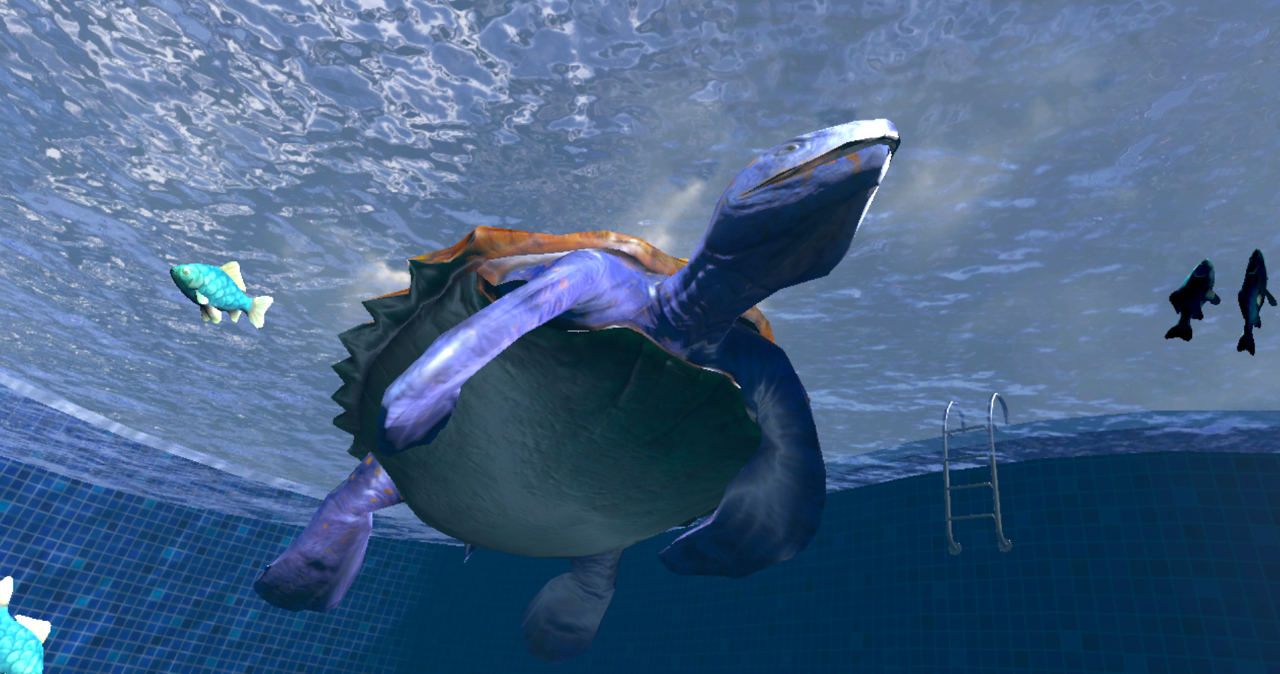
UC faculty teams with TV producers to explore horizons in VR
Nancy Jennings and Tony Liao are breaking open what we know about kids and VR
By: Michelle Flanagan
Imagine being submerged in a pool. A school of fish swims past and three dinosaurs come to visit you. They swim around you, over your head, making noises. Do you reach out? Stay quiet and hide?
That’s exactly what children involved in a ground-breaking virtual reality (VR) study at the University of Cincinnati’s McMicken College of Arts and Sciences were faced with. While virtual reality splashed onto the scene for average users with Google Cardboard in 2014, much research remains to be done on early adopters in non-medical applications. UC faculty are working to bridge that gap.
Associate professor of Communication Nancy Jennings and assistant professor of Communication Tony Liao teamed up to research children’s reactions to a VR experience that involved dinosaurs swimming in a pool.
The study was conducted in partnership with Toronto-based Sinking Ship Entertainment, the production company behind the Emmy-nominated children’s TV show “Dino Dana,” which is exploring creating a VR extension for the show. Because the industry is still unclear about how children might respond to VR, the producer wanted to conduct a study to determine how to maximize both the entertainment and educational potential of its program.
The VR experience
The study involved 29 children, ages six to eight, who came into the lab to experience the VR and were then interviewed about the difference between VR and reality, and had their physical responses to the VR stimulus measured.
Sinking Ship Entertainment designed the VR experience, which had two components. First, the child saw a visualization of an open field, which featured a field of grass, trees, butterflies, and chirping birds. Here, the child could adjust to wearing the VR headset and ensure everything was working correctly. After that stage, they moved in to a visualization of a swimming pool. In the pool, the child was immersed under water where a school of fish was always swimming by. In succession, three different dinosaurs swam past the child, each of which made a sound and then completed a short circle around the child. This visualization was on a loop, so the three dinosaurs visited the child twice and lasted five minutes.
Jennings, who also serves as director of UC’s Children’s Education and Entertainment Research Lab, explains that this study was exploratory in some ways, simply because so little is known about children’s VR experiences. “The manufacturers of many VR devices do not recommend VR use for children under the age of 12 or 13. However, we know that once a VR device is in the household, younger children are going to use it,” she says. “In fact, half of the children in our study had already had a VR experience prior to participating!”
While the decision to base the study on dinosaurs was largely due to the partnership with the creators of “Dino Dana,” Jennings says that dinosaurs provide rich subject matter because they were real, but are no longer alive. This gives the study an interesting twist in the ability to explore children’s understanding of what is real versus pretend in a virtual setting.
Pioneering research
Groundbreaking research such as this project supports the university’s Next Lives Here strategic initiative, which emphasizes academic excellence, urban impact and innovation. The innovation platform encourages the university as a whole to come together to focus on solving new and emerging problems with creative solutions. This imeans finding new ways to learn, which will lead to new ways to solve problems locally, nationally and globally.
To date, research has produced a notable body of findings around VR and its medical uses, but there is a comparative lack of study around everyday uses of the technology.
“The difference with those [studies about VR, medicine, and children] is often that they are tailored clinical interventions, and sometimes involve very expensive and complex whole room virtual simulation environments,” explains Liao. “Ours focused on questions not related to a particular medical outcome, but more generally about processing and reality distinction. It looked at a more everyday application of a child playing a game.”

UC associate professor of Communication and researcher Nancy Jennings.
He further explains, “The focus of medical studies tends to be on outcomes and outcomes alone. While this is to be expected, they do a better job telling us whether a technology like VR is effective, as opposed to why these technologies have the effect they do. Also, because our study relies on qualitative interviews (as opposed to biometric or physiological measures common in health studies), we actually get a sense of how children perceive and make sense of VR environments.”
On top of medical VR studies, researchers have tried to understand the effects of both TV and video games, especially in adolescent children. Because VR is, in some ways, the evolution of those technologies, there are some similarities.
“We’ve focused less on video games and more on television studies to give us a broader scope and also because many of the video game studies are based on TV research,” says Jennings. “However, there are affordances of VR that are different than other technologies which does put it in a new ballpark. These are some things we’re trying to tease out with our research.”
Liao expands on those differences. “First, the immersive possibilities of VR alone (3D, stereoscopic, point-of-view tracking, sound, haptic interactions) could offer a much more in-depth experience compared to other technology. Second, VR through a standalone device is something that children engage in as a single user. Unlike other media settings where children could rely on the reactions and cues of other people in the environment, assessments of reality in VR are more reliant on the content alone. Lastly, while the stages of childhood development are well studied, new technologies are continually pushing the boundaries of human interaction.”
New discoveries

UC assistant professor of Communication and researcher Tony Liao.
After working with 29 kids, what did the study find?
Children seemed to walk away with the understanding that the VR experience wasn’t real, but they did discuss how real it felt.
“I was surprised by how verbal the children were when talking about their VR experiences,” said Liao. “I think they were quite excited, but they also said several things that were quite profound when I thought about it, and they felt things that I didn’t expect. One of them talked about moving away from the fish in the pool not because she was afraid of the fish, but because she didn’t want to get the smell of the fish on her that might attract the dinosaurs.
“They were so immersed in the VR environment that they were worried about other sensory possibilities besides just visual/audio.”
Jennings encountered similar surprises. “It was surprising to see the children actually try to touch the dinosaurs. I thought they would be too afraid or treat the experience like a TV experience. But many actually tried to touch things in the VR experience,” she said. “I was also a bit surprised at how scared some of the children became. Even though they thought the experience wasn’t real – it was pretend, many thought it ‘looked’ real so they became very frightened. Also, some identified digital ‘glitches’ in the scenes that helped them decide it wasn’t real and they were safe.”
The findings from this study will be published in an upcoming issue of the Journal of Virtual Worlds Research, paving the way forward for more research surrounding everyday VR. Entitled, “Could the Virtual Dinosaur See You? Understanding Children’s Perceptions of Presence and Reality Distinction in Virtual Reality Environments,” it is authored by Tony Liao, Nancy A. Jennings, Laura Dell, associate dean of the UC College of Education, Criminal Justice, and Human Services and Chris Collins, director of the Center for Simulations & Virtual Environments Research.
Featured image at top: Virtual reality environment from the perspective of study participant. Courtesy: UCSIM I Center for Simulation & Virtual Environments Research.
Related Stories
Seven common startup challenges and how to solve them
April 3, 2025
Launching a new business isn’t an easy endeavor, but it’ll be simpler for entrepreneurs who consider common startup challenges and plan out ways to solve them.
Hands-on experiences, real-world impact
April 3, 2025
University of Cincinnati second-year medical sciences student Jay Patel is pursuing his passions as founder of the Dahyabhai Foundation, a cancer researcher and a Portman Fellow.
IMPACT Innovation at IDD Education Center celebrates milestone
April 3, 2025
The IDD Education Center’s IMPACT Innovation program celebrates a major milestone as associate Haley secures a position at Adrian Durban Florist. Through hands-on training, mentorship, and community partnerships, IMPACT Innovation helps adults with autism develop independence, communication, and workplace skills. Haley’s mother shares how the program has supported her daughter's growth, while program director Genna Kieper highlights the role of job coaching in Haley’s success. Adrian Durban Florist, a long-time partner, continues to be a champion. The IDD Education Center remains committed to expanding employment opportunities for individuals with disabilities.
